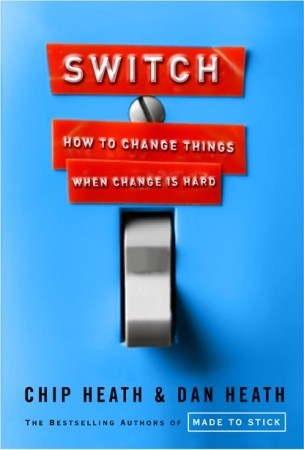One of my new goals is to read at least one book that might help me be a better librarian or manager a month. They don't all have to be actually aimed at librarians, but I will be reviewing them under the tag "professional lit". To that end my first book was about change. It was the August book, but I am a bit delayed on the blogging.
Switch: How to Change Things When Change is Hard by Chip Heath and Dan Heath. Published in 2010 by Crown Business. 320 pages.
Change is ever present in our personal and work lives. A lot is being written about how libraries are facing a crisis/ebook revolution/time of change. And yeah. But that was also true when we went to computers and integrated library systems (ILS for the acronym geeks out there). It was true when we dumped the card catalog and went to OPACs (online public access catalogs). It was true when we racially integrated libraries. Back in the 16th century there was probably a librarian grousing that switching to the Gregorian calendar would really mess up the acquisition records.
Okay a lot of those things happened before my time in librarianship. But my point is that we have always been a profession who faced change.
My library system has been going through a lot of change. As a middle manager, I've been responsible for helping to implement some of that change, but I have not always been in on the meetings or decisions to make that change. And of course my personal life has had a lot of change lately, some good some not so good. Thus change and change management are of special interest to me.
Bottom Line: This book is really good. You should read it if you are interested in change or management. It has a good basic framework that is supported with practical examples from business, social work, non profits, and personal life. It avoids the trap of speaking too much in scholarly jargon and produces an approachable book that doesn't feel dumbed down.
Basic framework: To make change happen, balance the rational and emotional parts of people's minds. Give motivation to their emotional part of the brain and clear direction to their rational part.
I'm not going to quote the entire book verbatim, but here are a few relevant examples.
Clear direction to the rational part of the mind. For example we could say "be more friendly and welcoming to the patrons". That's really vague. Most staff think they are friendly and welcoming, regardless of how they are perceived. A few years ago we heard a good framework at a customer service training. It's the 10-4 rule. When a patron is within 10 feet of you, make eye contact and smile. Acknowledge them non-verbally. The patron feels welcomed and is more likely to approach you if they need help. When a patron is within 4 feet of you, verbally greet them. Super easy and works like a charm. This very clear directive makes a world of difference in customer service.
Another great piece of advice. Shrink the change. Don't make people change the world all at once, give them small achievable steps.
Give people a head start. The example in the book was of a car wash that gave some customers a loyalty 8 punch card (and then the 9th was free) and other customers a 10 punch card to earn a free wash. The customers with the 10 punch card were told they were given two free punches for loyalty. So both groups had to earn 8 punches for the free wash. The customers who thought they had a two punch head start were more likely to complete their punch card.
We did something very similar with summer reading this system. When our youth services librarians visited schools, they gave out a large bookmark style summer reading promo that also had the first few lines of the summer reading chart so kids could start tracking the time they were reading. They were really excited to get a "head start" on their reading and were already invested in the program and (hopefully) more likely to come in and sign up.
Last crumb from the book: tweak the environment. To make change work, to make it easier and more likely to stick, change the environment in favor of the change. Years ago I worked at a library that wanted more people to use self check machines (staff cuts, staff reduced by attrition, more effective). Rather than just putting up a self check and hoping for the best, they totally redid the circulation desk. Instead of 3 clerk stations and one self check, you had to walk past four self checks to get to the only clerk station. That, and friendly staff members offering to help them use the self check, really helped people convert to self checks.
My favorite comment of that system, when someone worried that seniors wouldn't be able to deal with the new machines, was from my branch manager. He replied that those same seniors had been using ATMs happily for 20 years. And it really wasn't a problem.
In summary: this is a great book for librarians and managers and I highly recommend it. It has given me a lot to think about in terms of change in our system and in my own life personally.

No comments:
Post a Comment